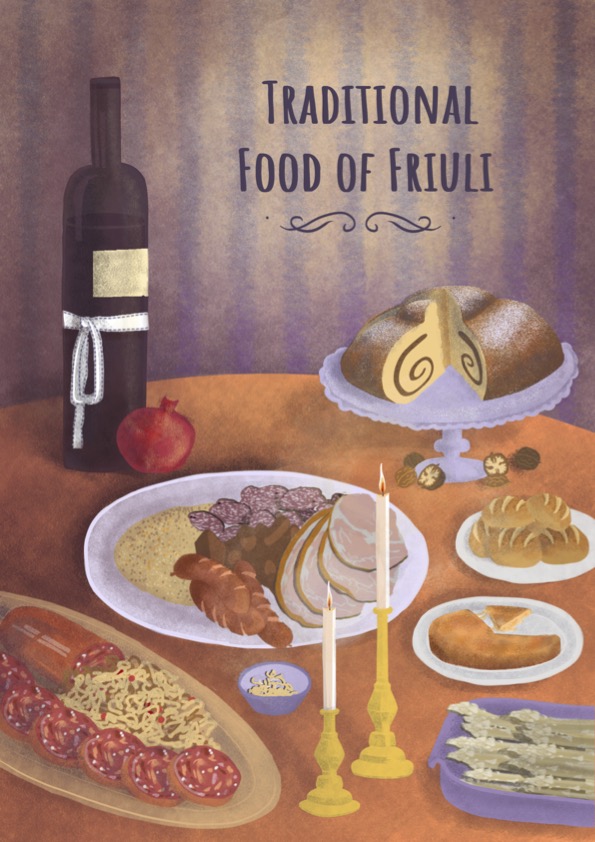by InTrieste
Friuli Venezia Giulia, renowned for its exceptional wines, offers a gastronomic journey that extends beyond its vineyards. From exquisite hams to “underground” cheeses and old family recipes, the region’s culinary heritage is rich and diverse. Here’s a curated list of traditional Friulian foods and where to savor them.
Frico
Frico, a dish born from clever cheese recycling, features shredded cheese (like the local Montasio PDO) and sometimes potatoes, fried until crisp yet malleable. At Ai Cacciatori in Cerneglons, an old-fashioned trattoria, they create a unique version using two-month matured Montasio, resulting in a soft and airy ball with a crispy exterior.
White Asparagus
Since the 19th century, white asparagus has thrived in the flat lands around Udine. A delicacy with a short season from April to May, it’s often served with eggs or grains. At Agli Amici 1887 in Godia, near Udine, chef Emanuele Scarello uses white asparagus creatively in dishes like herbs&potatoes gnocchi with cheese fondue.
Muset e Brovada
A quintessential local peasant dish traditionally served at Christmas, Muset e Brovada combines fermented white turnips (brovada) and a large pork sausage (muset). The pungent turnips cleanse the palate from the rich pork fat. Experience an authentic version at Là di Muk in Vergacco.
Pitina
Pitina, a unique blend of sausage, meatball, and salami, hails from the mountainous Val Tramontina. Made with chamois or goat meat, it offers an intense flavor, enjoyed raw or cooked. At Ai Cacciatori restaurant in Cavasso Nuovo, they serve Pitina in various ways, from pasta sauce to boiled in broth with polenta.
Cherry Gnocchi
A legacy from Austria, cherry dumplings are a summer delight, with a version featuring plums in autumn. Boiled potato dough encases a pitted cherry, sautéed with butter and sugar. Sale e Pepe in Stregna offers a savory version without sugar, served as a pasta dish.
Rosa di Gorizia
Known as the “Gorizia’s rose,” this chicory variety is crunchy and less bitter than others. Rare and precious, it grows near Gorizia in winter and is best enjoyed raw or in salads. Rosenbar restaurant serves it with bean soup, roasted bacon, vinegar, or grilled squid and polenta.
Il Bollito
In Trieste, the boiled beef tradition takes a unique twist with “bollito.” Almost every part of the pig is boiled in a pot, served with cumin sauerkraut, mustard, and grated horseradish. Buffet da Pepi is an iconic place in Trieste to savor this dish.
Girini di Pasta
Tiny, twisted “crumbs” of pasta made from egg and flour dough are boiled and seasoned with seasonal greens, San Daniele ham, Gorizia’s rose, and goat cheese. Chef Alessandro Gavagna at La Subida creates this delightful recipe inspired by local traditions.
Pestat di Fagagna
Pestat, a Slow Food Presidium, is a lard-based food flavored with herbs and vegetables. It enhances the flavor of roasted potatoes, meats, soups, and stews without excessive salt. Casale Cjanor in Fagagna uses a red version to season pasta or toasted bread.
Jamar
Jamar, an outstanding cheese from Prepotto, matures in a karst cave for 12 months. With an intense flavor and creamy texture, it’s perfect on its own or used in recipes. Devetak in the same area prepares a fantastic risotto and fresh pasta with sausage and Jamar.
Smoked Trout
Cold or hot-smoked trout, sourced from regional lakes, is a delicacy enjoyed on toasted bread or in salads. Casa Rossa ai Colli in Ragogna serves them on a cold barley-risotto salad with citrus, urticions (hop shoots), and beer mayo.
Gubana
This spiral-shaped yeast cake, filled with nuts, raisins, pine nuts, sugar, and lemon zest, has roots dating back to at least 1409. Traditionally served during special occasions, it pairs well with grappa or Slivowitz. Try it at the Enoteca di Cormons along with other local products and wines.
Friuli Venezia Giulia’s culinary offerings are a testament to the region’s rich history and cultural influences. Exploring these traditional dishes provides a genuine taste of Friulian heritage.





























